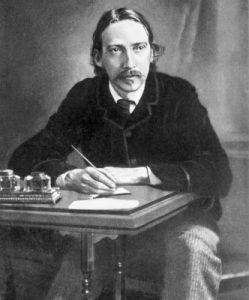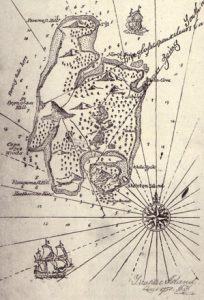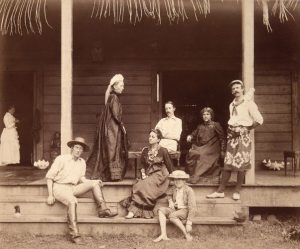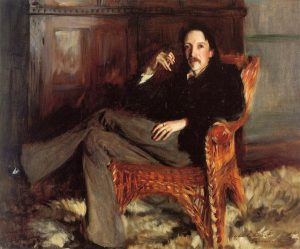‘Here he lies where he longed to be / Home is the sailor, home from the sea / And the hunter home from the hill’ form the last lines of an epitaph and mark the grave of an extraordinary man. Robert Louis Stevenson wrote his own elegy and determined his final resting-place, on top of Mount Vaea overlooking Vailima, his former home and estate on Samoa. There where he longed to be. He was only 44 years old.
3 December marks the anniversary of Robert Louis Stevenson’s death. Author of classics like Treasure Island, Kidnapped and Strange Case of Dr Jekyll and Mr Hyde. But he was so much more than that: poet, playwright, historian, anthropologist, traveller and an exceptionally modern writer.
Born on 8 November 1850 in Edinburgh, the childhood of Robert Lewis Balfour Stevenson was dominated by his ill-health and tuberculosis. When he was eighteen months old his nurse Alison Cunningham joined the household. With love and gratitude he later looked back on the unwearied sympathy ‘Cummy’ had always displayed. “She was more patient than I can suppose of an angel”. It also was a youth full of stories he, in spite of the long periods of illness and sleepless nights, looked back on fondly.
Wanderlust
Robert Louis Stevenson, RLS as he liked to be called by family and friends, was a much travelled and self proclaimed ‘amateur emigrant’. He travelled the seas out of Wanderlust, in search of new places, ideas and adventures, but also, and not least because of his health. Always looking for a climate that suited his sickly body. He crossed the Channel to the European continent many times and visited countries like Belgium, France, Germany, Austria and Italy.
Regularly he returned to the artist colony at Grez-sur-Loing near Fontainebleau, about 50km south of Paris. In 1876 he met here Fanny Van de Grift Osbourne, an independent American and ‘New Woman’, together with her two children, Belle and Lloyd. She returned to America and RLS decided to follow his future wife ‘across the plains’ in 1879. After Fanny had divorced her husband Samuel Osbourne in 1880, Stevenson married her. Following a two-month honeymoon, RLS, together with Fanny and Lloyd, leave America for Great Britain.
After Fanny and Lloyd had preceded him, RLS in 1888 set out to America once more, leaving his fatherland for the last time. Over the years his health had been failing more and more, and someone suggested the Pacific climate may be beneficial to him. After three years of travelling – from Hawaii to Samoa – Stevenson in 1890, finally settles Vailima, ‘Five Waters’, on Upolu, one of the Samoan islands, together with his wife and stepson.
RLS describes the Samoans as “God’s best, his sweetest work”. He bought a stretch of land of 127ha, including the 1300 metre high Mount Vaea, not far from Apia. He established a plantation that was managed largly by Fanny. The island had an adequate postal service, not unimportant to Stevenson, as he published his novels mainly in serial form. All his life he had been drawn back to Scotland, like a magnet. Now, ‘at home’ at last in Samoa, but still Scotland was never far away, always close to his heart.
Tusitala
Tusitala is the name by which Stevenson was known in Samoa. And a storyteller he is! As he said himself: “fiction is to the grown man what play is to the child; it is there that he changes the atmosphere and tenor of his life”. But he was not just a storyteller: plays, poems, essays, travelogue, fantasies and fables, romances and adventure stories, short stories, in short, almost all genres are covered by RLS. And don’t forget his letters, they are true gems in the treasure-chest of his legacy.
The dividing line between ‘children’s books’ and those for ‘grown-ups’ is a thin one with Stevenson, if such a line can, or should, be drawn at all. There are many adults who enjoy reading books that are supposedly written for children. If there is one place without limits, then in stories and your imagination. Thank goodness!
Treasure Island (1883) originated in a cold and wet cottage in Braemar in 1881 after Stevenson returned to Scotland from America, together with Fanny Loyd. RLS drew a map of an imaginary island to amuse his stepson Lloyd, and so created a tropical paradise where treasure was hidden on the spot marked with an ‘X’. Stevenson says about this episode:
“as I poured over my map of Treasure Island in the cottage, the future characters of the book began to appear there visibly among imaginary woods”… “I thought if this doesn’t fetch the kids, then they have gone rotten since my day”. Nothing’s rotten, the story is still as fresh as when it was invented and told to Lloyd.
The novel’s most famous character, Long John Silver, was created from a combination of a local Braemar tradesman and one of Stevenson’s oldest and dearest friends, William Ernest Henley, a bear of a man who had lost his leg to tuberculosis. Our modern image of a 17th century pirate is in the same way almost literally taken from Treasure Island. I for one can’t watch the ‘Pirates of the Caribean’ films without thinking of Long John Silver and his creator. (The same goes for the Admiral Benbow, which always brings me back to a pub in Chapel Street, Penzance, and makes me think of good food and drink, not surpisingly also favourite topics of RLS).
Several novels are situated in a historical Scotland. Kidnapped (1886), Catriona (or David Balfour, 1893), The Master of Ballantrae (1889), and the unfinished Weir of Hermiston, published posthumously in 1896.
The Strange case of Dr Jekyll and Mr Hyde (1886) was an instant succes and had, still has, a great impact. Many versions and films have since been made about the oppressive story about crimes, guilty secrets and the duality of good and evil in every person. “Conceived, written, rewritten, rewritten and printed” in ten weeks’ time during the autumn of 1885.
The travelogue form a separate story altogether and paint a good picture of RLS as anthropologist. The trilogy of travel memoirs describes the journey from Scotland to California in 1879-1880. The Amateur Emigrant forms the first part and covers journey to New York. In Across the Plains the journey continues by train to San Francisco. The Silverado Squatters finally, tells about the travels of Robert, Fanny, and his stepson Lloyd, during the two-month honeymoon.
The immigrant train to San Francisco has three sections, one for women and children, one for men, and one for Chinese. Stevenson notices that while the Europeans look down on the Chinese for being vermin and dirty, that “in their efforts after cleanliness they put the rest of us in shame” and that in fact the Chinese carriage was “notably the freshest of the three” and the “least offensive”.
RLS also speaks about a group of Cornish miners, looking for work and a better life: ”I can make nothing of them at all. A division of races, older than and more original than that of Babel, keeps this close, esoteric family apart from neighbouring Englishmen. Not even a Red Indian seems more foreign in my eyes. This is one of the lessons of travel – that some of the strangest races dwell next door to you at home.”
Death
Even though his live was dominated by ill-health, Robert Louis Stevenson died unexpectantly at the age of 44, probably of a cerebral haemorrhage, on 3 December 1894, between 7-8 pm. The locals knew Tusitala wanted to be buried on top of Mount Vaea, and the same evening they started cutting a way up the mountain, so RLS could be buried the next day on a spot overlooking the sea and his ‘home’. His tomb is marked with the epitaph he wrote for himself:
Under the wide and starry sky
Dig the grave and let me lie:
Glad did I live and gladly die,
And I laid me down with a will.
This be the verse you ‘grave for me:
Here he lies where he long’d to be;
Home is the sailor; home from the sea,
And the hunter home from the hill.
Stevenson died just four and a half years after settling on Samoa. The locals have not forgotten him, neither have his readers. From the first day the village of Vailima developed around Stevenson’s dream house and formed the centre of the small expat community on Samoa during his days. The completely renovated building was opened to the public in 1994 as Robert Louis Stevenson Museum. Close to the museum a climb to the top of Mount Vaea and the gravesite begins.
Three Robbies
“I am the last of Scotland’s three Robbies, Robbie Burns, Robbie Fergusson, and Robbie Stevenson – and how hardly life treated them all, poor devils!” This way, Lloyd Osbourne quotes his stepfather in An intimate portrait of R.L.S.
Stevenson sympathises with his predecessors and the three literary heroes come together at the grave of the first, Robert Fergusson (1750-1774), Scotland’s forgotten poet. Only twenty-four years old when he died and originally buried in an unmarked grave Canongate Kirkyard on Edinburgh’s Royal Mile. Robert Burns (1759-1796) dying at such a young age too, out of acknowledged debt to him, offered to pay for a memorial stone and also composed a three verse epitaph for the poet who was such an inspiration. The first stanza is carved on the headstone put up in 1787:
‘No sculptur’d Marble here nor pompous lay
No storied Urn nor animated Bust
This simple stone directs Pale Scotia’s way
To pour her Sorrows o’ver her Poet’s Dust’
About a century later RLS agreed to renovate the headstone after it had been damaged, but his own premature death prevented him from making good his promise, though there is a plaque at the foot of Fergusson’s grave, added in 1995, recording his intention:
‘This stone, originally erected by Robert Burns,
has been repaired at the charges of Robert Louis Stevenson
and is by him re-dedicated to the memory of Robert Fergusson
as the gift of one Edinburgh lad to another’
In May 1894, Stevenson had written from Samoa to Edinburgh: “I wonder if an inscription like this would look arrogant”?
A handsome gift
Not arrogant at all! Robert Louis Stevenson gave and still gives so much to so many.
The most touching story perhaps is that where he gave away his birthday to a twelve year old girl, Anna Ide, who is unfortunate enough to be born on 25 December, and was that way cheated out of her birthday. Anna was the daughter of Sir Henry Ide, the American land commissioner in Samoa and good friend of Stevenson.
19 June 1891, Stevenson drew up a mock legal document transferring his birthday: “In consideration that Miss A. H. Ide, daughter of H. C. Ide, … was born, out of all reason, upon Christmas Day, and is therefore, out of all justice, denied the consolation and profit of a Proper Birthday; And considering that I, the said Robert Louis Stevenson, have attained an age when O, we never mention it, and that I have now no further use for a birthday of any description” … “Have transferred, and do hereby transfer to the said A. H. Ide, All and Whole of my rights and privileges in the 13th day of November, formerly my birthday, now, hereby, and henceforth, the birthday of the said A. H. Ide, to have, hold, exercise and enjoy” … “And I direct the said A. H. Ide to add to her said name of A. H. Ide the name Louisa – at least in private” … “In witness whereof I have hereto set my hand and seal this 19th day of June in the year of grace eighteen hundred and ninety-one”.
Lloyd Osbourne acted as one of the witnesses. The full text of the document, in a letter to Henry Ide can be found online here. Anna gratefully accepted the gift and always celebrated her birthday on 13 November. She later also adopted the full name Anna Louise Ide in the honour of Stevenson. Anna had no children of her own and left ‘the birthday’ to her niece Anita Leslie-King, “so that a mortal date can be carried on immortally”. Anita in turn passed it on to her granddaughter Heather Finn.
RLS remains to this day a dealer in generosity. Generation after generation is given the valuable pleasure of reading by the author. His biggest gift of all, to us all. So do we become the sailor on our way to the imaginary land of the storyteller, the hunter in search of treasure and adventure. Allowed to be a child for a while thanks to the stories.
An excellent look on the man, his life and work is offered on the website dedicated to RLS. Here you can wander around and lose your way to your heart’s content. It is all there, and more besides. A wealth of information, rewards guaranteed. Do yourself a favour and explore! Be that hunter, the sailor. There is treasure waiting… A meeting with RLS will give you a story to bring home, an adventure to remember and to cherish. Enjoy yourselves.


 Nederlands
Nederlands


